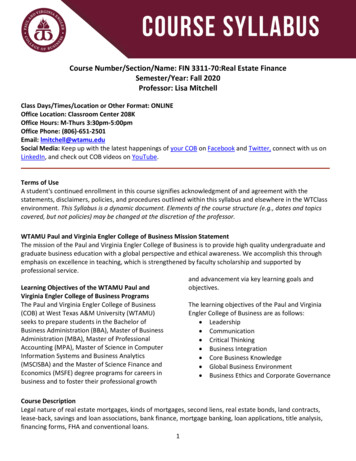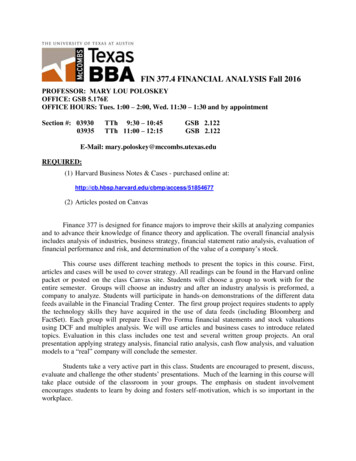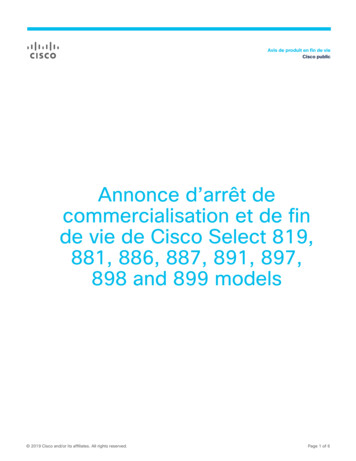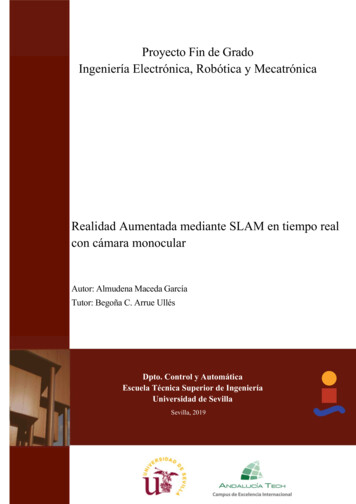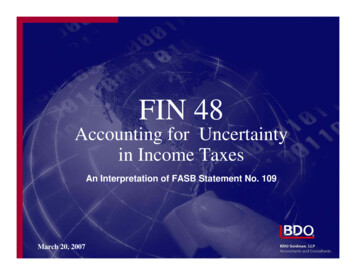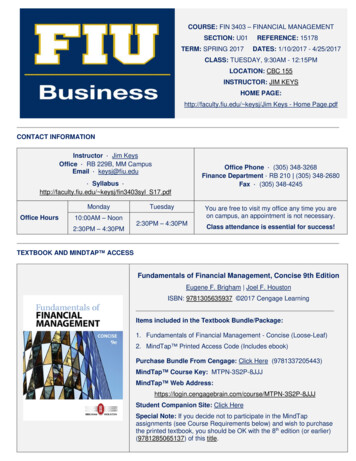
Transcription
COURSE: FIN 3403 – FINANCIAL MANAGEMENTSECTION: U01TERM: SPRING 2017REFERENCE: 15178DATES: 1/10/2017 - 4/25/2017CLASS: TUESDAY, 9:30AM - 12:15PMLOCATION: CBC 155INSTRUCTOR: JIM KEYSHOME PAGE:http://faculty.fiu.edu/ keysj/Jim Keys - Home Page.pdfCONTACT INFORMATIONInstructor · Jim KeysOffice · RB 229B, MM CampusEmail · keysj@fiu.eduOffice Phone · (305) 348-3268Finance Department · RB 210 (305) 348-2680Fax · (305) 348-4245· Syllabus ·http://faculty.fiu.edu/ keysj/fin3403syl S17.pdfMondayOffice Hours10:00AM – Noon2:30PM – 4:30PMTuesdayYou are free to visit my office any time you areon campus, an appointment is not necessary.2:30PM – 4:30PMClass attendance is essential for success!TEXTBOOK AND MINDTAP ACCESSFundamentals of Financial Management, Concise 9th EditionEugene F. Brigham Joel F. HoustonISBN: 9781305635937 2017 Cengage LearningItems included in the Textbook Bundle/Package:1. Fundamentals of Financial Management - Concise (Loose-Leaf)2. MindTap Printed Access Code (Includes ebook)Purchase Bundle From Cengage: Click Here (9781337205443)MindTap Course Key: MTPN-3S2P-8JJJMindTap Web -3S2P-8JJJStudent Companion Site: Click HereSpecial Note: If you decide not to participate in the MindTapassignments (see Course Requirements below) and wish to purchasethe printed textbook, you should be OK with the 8th edition (or earlier)(9781285065137) of this title.
COURSE PREREQUISITESPlease review information about prerequisites for this course: ACG 3301, STA 2023 or STA 2122, andMAC 2233 or MAC 2311, or equivalents with a grade of 'C' or higher, minimum 45 credit hours earned, UGBUstanding.COURSE DESCRIPTION AND OBJECTIVESFIN 3403 is the core finance course required of all business majors and it serves as the basis for all other coursesin the area of finance as well as providing the basic tools that every business student will need to be successful intheir chosen career. Emphasis is placed on the underlying principles and practices and how they relate to thedecision-making process faced by a financial manager charged with the objective of shareholder wealthmaximization and value creation. Although the focus is on corporate decision-making, the knowledge and skillsobtained in this course will also aid the student with personal financial and small business decision-making.COURSE LEARNING OUTCOMES Explain the concept of shareholder wealth maximization and how it relates to other possible objectives ofthe firm's management as well as the nature of the agency relationship inherent in the corporate structure.Describe how interest rates are determined and the role played by financial markets and institutions in theglobal financial system.Apply the concepts of compounding and discounting and utilize these tools to calculate the future value andpresent value of lump sums, annuities, and uneven cash flow streams and in addition calculate the value ofother variables such as the interest rate, time period, and periodic payment.Calculate the expected rate of return and risk of an individual investment as well as a portfolio of assets,including concepts and measurements such as standard deviation, correlation, diversification, and theCAPM (Capital Asset Pricing Model).Explain the determinants of intrinsic value and utilize these concepts to determine the value and yields ofbonds and preferred and common stocks.Calculate various measures of project profitability using traditional capital budgeting techniques includingPayback Period (PB), Net Present Value (NPV), Internal Rate of Return (IRR), and Modified Internal Rateof Return (MIRR).Analyze the concept of the cost of capital and how it is affected by the firm’s capital structure and applythese concepts to capital budgeting decision making and dividend policy.Utilize the information included in the income statement and balance sheet, discuss the importance of thecash flow statement and explain the difference between accounting net income for the firm and cash flow;analyze a firm's financial performance using financial ratio analysis.Distinguish between business and financial risk and discuss the analytical framework used to determine theoptimal capital structure.Describe the risk-return trade off involved in working capital management and explain how firms chooseappropriate levels of working capital and sources of short term financing.MAJOR AND CURRICULUM STUDENT LEARNING OUTCOMES TARGETEDApply critical thinking skills to complex business problems including: Identifying and evaluating relevant issuesand information; generating and evaluating possible solutions to problems. Use quantitative analytical skills to:Identify and analyze material factors that are involved in business problems; determine and apply appropriateproblem solving techniques to business problems. Use information technology as a tool to perform essentialbusiness tasks.TEACHING METHODOLOGYThe structure of this class makes your individual study and preparation extremely important. You should read andbe familiar with the material in the assigned chapter and attempt to solve some problems before the lecture. Thelecture will focus on the more difficult aspects of each chapter and on problems and concepts that deal with the
material. After the class you should review your notes and in the process work additional relevant problems andquestions at the end of the chapter. There are additional resources available in MindTap that many students willfind helpful.Participation: You are expected to attend all of the lectures for the semester. If you miss any material, it is yourresponsibility to view the recorded lectures or obtain the information from another student. Please do not conductprivate conversations while class is in session, however, participation in class discussions is expected.Suggested study procedures: Access the Textbook folder in MindTap for the reading content. Before class andprior to reading the chapter, complete the “Why Is This Important to Me” survey (graded).Utilize the (non-graded) assessments and resources in the MindTap Reader (Quizzes, ConceptClips,Problem Walkthroughs, Videos, Notes, etc.) to enhance your understanding of the material.Review the Self-Test Questions and Problems found at the end of each Chapter. Solutions are found inAppendix A of the text for the selected chapter.Assemble exam-type questions using the Adaptive Test Prep app for each section of the textbook. Reviewyour results, including the question rationale, and focus on problem areas. Access the Practice Assessments andResources folder in MindTap for practice problems and cases, exam-type questions, Excel spreadsheets,and lecture notes (see below for more details). Access the Graded Assessments folder in MindTap and completethe two assignment sets (see below for more details) by the due dates listed in the Course Calendar.Participate in class discussions and activities both verbally as well as with the Socrative tool (see below).Access the Recorded Lectures through Blackboard to review the material covered in class.Track your progress and grades for all assignments (graded and ungraded) using the Progress tab inMindTap .Employ the library of learning apps (MindApps) accessible via the MindApp bar in MindTap to customizeyour learning experience, including the Adaptive Test Prep app which enables the student to practiceexam-type questions.Post your questions in the Discussion Forum in Blackboard and view previously answered questions.Utilize the services of the course Teaching Assistant (TA); visit the Finance Department office in RB 210 forschedule and availability.Use Course Mail in Blackboard, my FIU email address (keysj@fiu.edu), or visit during office hours tocommunicate privately.Prepare for and take the on-campus Exams as scheduled in the Course Calendar. MINDTAP MindTap is a fully online, highly personalized learning experience, combining readings, multimedia, activities, andassessments into a singular Learning Path. The MindTap course is enriched through a library of learning appscalled MindApps accessible via the MindApp bar. Examples of apps include homework solutions, text-to-speech,dictionary, web video, social media integration, and more. The MindTap learning path begins by engagingstudents in the content by showing its relevance to their own lives. It then continues the progression of learning witha new, interactive eReader and valuable videos providing students with on-demand problem-solving examples.Continuing on in each chapter, MindTap then provides practice opportunities complete with immediate, writtenfeedback, before finally asking students to move on to complete their graded homework assignments.MINDTAP PRACTICE ASSESSMENTS AND RESOURCESThere are a number of resources in MindTap that will help you to learn the material and prepare for exams.Preparing for Finance - Calculator tutorials (HP-10BII and TI-BAII Plus) and prerequisite review material in theareas of Accounting, Economics, Math, and Statistics.
Interactive Reader with ConceptClips and Quizzes - In addition to eReader tools that allow students to capturehighlights and notes in a common location for easy review, an app that will read the text aloud to them, andembedded practice quizzes, students will find interactive tools (ConceptClips) that support learning key financialterminology.Practice Assessments and Resources - Includes Blueprint Problems and Finance in Action question setsdesigned to deepen your understanding and appreciation of core financial concepts. Problem Walkthroughsfurther explain difficult concepts and homework roadblocks by walking students through solving problems similarto those in the text from start to finish. Problem solutions are provided using each of the following methods, whereappropriate: A formulaic approach, solving with a financial calculator, and solving using Excel.Adaptive Test Prep- Students decide how many quiz questions they want to review, and the appgenerates a preparatory quiz -- using questions similar to exam questions. The app provides students withfeedback on every question, and students can continue practicing until they feel confident about taking the exam.MINDTAP GRADED ASSIGNMENTSThere are three types of graded assignments that you will take in MindTap . You will have a limited number (3) ofattempts and all of the graded assignments have firm deadlines (see below). Before taking a graded assessment,it is recommended that you read the chapter, ask questions, and use additional resources (see below) to prepare.Your assignment grade will be based upon the total points that you accumulate out of the total points available.Why Is This Important To Me?Students, particularly non-Finance majors, commonly wonder why it's important for them to learn and understandcertain concepts in corporate finance. By beginning the learning path for each chapter with "Why is this Importantto Me?", MindTap sets the stage for students to understand how the topics covered in that chapter will have adirect, positive impact in their own lives – thus more effectively engaging them in the material to follow.Each chapter that we cover will have a "Why is this Important to Me? assignment/survey in which participationpoints are awarded upon completion. Deadlines will be indicated in the Course Calendar (below) and are firm.Graded Problem SetsMost chapters that we cover will have an assignment taken from the Problems section at the end of each chapter.The problems will be the same as found in the text although the numbers will change with each attempt. You willbe given three attempts for each problem and the highest grade will be recorded for grading purposes. Deadlineswill be indicated in the Course Calendar (below) and are firm. Note: Submit each question individually!Graded AssignmentEach chapter that we cover will have an assignment which will include both quantitative and qualitative(conceptual) items. You will be given three attempts for each problem and the highest grade will be recorded forgrading purposes. Deadlines will be indicated in the Course Calendar (below) and are firm. Note: Submit eachquestion individually!DISABILITY NOTICEIf you have a disability and need assistance, please contact the Disability Resource Center (University Park: GC190;305-348-3532) (North Campus: WUC139, 305-919-5345). Upon contact, the Disability Resource Center will reviewyour request and contact your professors or other personnel to make arrangements for appropriate modificationand/or assistance.RELIGIOUS HOLIDAYSThe University's policy on religious holidays as stated in the University Catalog and Student Handbook will befollowed in this class. Any student may request to be excused from class to observe a religious holy day of his orher faith.
SOCRATIVESocrative is a free cloud-based student response system for enhancingclassroom engagement, assessment and personalization. Socrative runson tablets, smartphones, and laptops.DeviceDownload / Access oom #873687The browser-based solutionsupports Internet Explorer,Firefox, and Chrome browsers.Requires iOS 6.0 or later.Compatible with iPhone, iPad,and iPod touch.For Android devices.Requires Android 4.0.3 and up.FINANCIAL CALCULATOR AND TIME VALUE OF MONEY RESOURCESHewlett-PackardFinancial: HP-10bII · HP-12C · HP-17bII Calculators withfinancial functions:Texas InstrumentsFinancial: BAII Plus · BAII Plus ProfessionalGraphing / Financial: TI-83 · TI-84Financial calculatorTutorials and fiu.edu/ keysj/Other Resources.htmHow to choose afinancial ancial calculator recommendationsTime value of moneyformula sheet:http://faculty.fiu.edu/ keysj/TVM Formulas Brigham.pdfTime value of moneyinterest tables:FV FVA PV PVABusiness Finance Online(online calculators)http://www.zenw
course: fin 3403 – financial management section: u01 reference: 15178 term: spring 2017 dates: 1/10/2017 - 4/25/2017 class: tuesday, 9:30am - 12:15pm location: cbc 155
